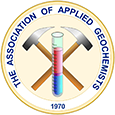FRANK C. CANNEY (1920-2000)
Frank C. Canney, a founding member of the AEG, died October 7, 2000, one day before his 80th birthday, after a brief illness. Frank was one of the early developers of geochemical exploration techniques from the 1950s to 1970s.
Born in Ipswich, Massachusetts, Frank earned a BS in geology at the Massachusetts Institute of Technology (MIT), then served in the U.S. Navy during World War II as a gunnery officer on the aircraft carrier Franklin, where he was one of the crew members who saved the ship after she was kamikazied and nearly sunk by Japanese warplanes. Following the war, Frank returned to MIT, where he earned his Ph.D. degree in geochemistry, specializing in the determination of the alkali metals in pelitic rocks through emission spectrography.
Because of his expertise in emission spectrography, Frank was recruited by the U.S. Geological Survey to work with A. T. Myers and F. N. Ward to develop the first truck-mounted D.C. arc emission spectrographic laboratory for use in geochemical exploration field projects. This instrument was described in Economic Geology, v. 52, no. 3, 1957. Sceptics claimed that such a delicate optical instrument could not function properly after having been driven long distances in a truck, sometimes over rough roads; but the original spectrograph outlasted three truck chassis, and always produced accurate precise results, much to the credit of its designers.
With Harold Bloom and John Hansuld, Frank was an organizer of the second International Geochemical Exploration Symposium held in April 1968 at the Colorado School of Mines, at which initial efforts were made to establish the present Association of Exploration Geochemists. Frank was the chief editor of the proceedings of this geochemical symposium, published as a Quarterly of the Colorado School of Mines in January, 1969.
Employed his entire career by the U. S. Geological Survey, Frank undertook field geochemical projects at the Cobalt District, Idaho; in Maine, where he worked on developing field methods for geochemical exploration in glaciated terrain; and finally in primitive areas being considered for inclusion in the national wilderness system. With D. B. Hawkins, he developed a field analytical method, cold acid extractable copper using the colorimetric reagent 2,2' biquinoline, and he was one of the early researchers to recognize the scavenging effect of manganese-iron oxide minerals in surficial materials. He trained several exploration geochemists who later established careers in the Geological Survey and the mining industry.
Frank was a member of the American Chemical Society, the Geological Society of America, the Society of Economic Geologists, the Association of Exploration Geochemists, the Society of Mining Engineers of AIME and the Denver Region Exploration Geologists Society.
He is survived by his wife, Isabel, and a son, Randy, a Denver attorney.
Edwin V. Post. Lakewood, Colorado
